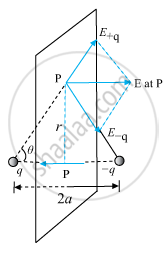Advertisements
Advertisements
Question
Drive the expression for electric field at a point on the equatorial line of an electric dipole.
Solution
Electric Field for Points on the Equatorial Plane:

The magnitudes of the electric field due to the two charges +q and −q are given by,
`E_(+q)=q/(4piepsilon_0)1/(r^2+a^2)` .....(i)
`E_(-q)=q/(4piepsilon_0)1/(r^2-a^2)` .....(ii)
The directions of E+q and E−q are as shown in the figure. The components normal to the dipole axis cancel away. The components along the dipole axis add up.
∴ Total electric field
`E=-(E_(+q)+E_(-q))cos theta.hatp`[Negative sign shows that field is opposite to `hatp`]
`E=-(2qa)/(4piepsilon_0(r^2+a^2)^(3/2))hatp` .....(iii)
At large distances (r >> a), this reduces to
`E=-(2qa)/(4piepsilon_0(r^3))hatp` .....(iv)
`because vecp=qxxvec(2a)hatp`
`therefore E=(-vecp)/(4piepsilon_0(r^3))` (r >> a)
APPEARS IN
RELATED QUESTIONS
Depict the orientation of the dipole in (i) stable, (ii) unstable equilibrium in a uniform electric field.
Derive the expression for the electric potential due to an electric dipole at a point on its axial line.
Depict the equipotential surfaces due to an electric dipole.
Derive an expression for the intensity of electric field at a point in broadside position or on [4)
an equatorial line of an electric dipole.
Two particles A and B, of opposite charges 2.0 × 10−6 C and −2.0 × 10−6 C, are placed at a separation of 1.0 cm. Calculate the electric field at a point on the axis of the dipole 1.0 cm away from the centre.
An electric dipole consists of two opposite charges each 0.05 µC separated by 30 mm. The dipole is placed in an unifom1 external electric field of 106 NC-1. The maximum torque exerted by the field on the dipole is ______
An electric dipole is placed at an angle of 30° to a non-uniform electric field. The dipole will experience ________.
Polar molecules are the molecules ______.
